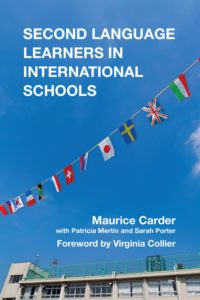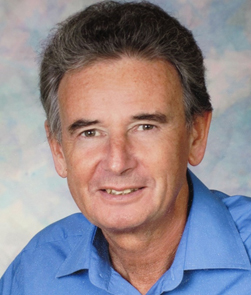New book champions NNESTs and TESMC in ESL and MT provision
by Maurice Carder
In many international schools the majority of students aren’t native speakers of the school’s Language of Instruction, which in 90% of cases is English. Clearly then, the schools need to provide a programme structure, curricula and accreditation that take account of this. Language is at the centre of everything we do, so school students need a deep and broad competence in the language in which they are learning. Acquiring command of this language requires years of continuing study before they attain the levels required for success. Consequently Second Language Learners (SLLs) face an enormous challenge.
My career entailed SLLs around the world. In the final 30 years  or so, I headed the Secondary ESL & Mother Tongue Department at the Vienna International School. Although I’m a native speaker of English, my time living in countries where I had to learn another language gave me valuable insights into what it means to be a second language learner. Throughout my career I was always digging deeper to try and see how better programmes could be provided for SLLs. When these failed to materialize, even after apparently successful representations to curriculum and accreditation agencies, I spent my final active years researching and collecting evidence for why such programmes were crucial. The results are now published in a book: Second Language Learners in International Schools.
or so, I headed the Secondary ESL & Mother Tongue Department at the Vienna International School. Although I’m a native speaker of English, my time living in countries where I had to learn another language gave me valuable insights into what it means to be a second language learner. Throughout my career I was always digging deeper to try and see how better programmes could be provided for SLLs. When these failed to materialize, even after apparently successful representations to curriculum and accreditation agencies, I spent my final active years researching and collecting evidence for why such programmes were crucial. The results are now published in a book: Second Language Learners in International Schools.
What I learnt was often unedifying as it related to areas involving collegial relations and management which are not welcome in the international school atmosphere of success and achievement. Yet, SLLs are so frequently the majority in international schools and they deserve the best that schools can offer. Instead they are often treated as a ‘problem’ that can somehow be dealt with, mostly by borrowing terms such as ‘support’ and opting for peripheral provision from unqualified assistants from the national education system, to whom SLLs are immigrants, exposed to derogatory comments and negative views, and the consequent poor delivery that is regularly reported in the press.
The chapter in the book on the politicization of ESL and MT provision relates in detail how this has arisen. It identifies ‘contrived collegiality’ as managements’ attempts to force liaison between content and Second Language (SL) teachers that, because of teacher relationships, is likely to fail SLLs. Too often school leaders promote a short-term ESL in-service model for teachers but this frequently proves to be not only inadequate, but ‘quick and dirty’: the Teaching ESL Students in Mainstream Classrooms (TESMC) course appears to be the best solution.
The book offers evidence for the viability of Non-Native ESL Teachers (NNESTs) – that NNESTs have the best insights and are also credible role models for SLLs. Many international schools entice parents with the promise that all their teachers are native English speakers, leading parents to believe that this will guarantee that their children will develop a native-speaker command of English. School leaders would do well to stop explaining why SL speakers are not native speakers and talk instead about the processes of becoming bilingual. NNESTs have many advantages over native speakers, notably their ability to explain second language features in ways that students can understand. Research shows that students’ perceptions of teachers affect their motivation and achievement, so minority teachers can often form strong ties with SL students, and students will have more realistic role models. And in any case, in international schools that institute the whole British ‘support’ model of ‘EAL’, the native speakers of English are not qualified teachers.
My years of experience teaching SLLs, and being closely involved with curricular development and accreditation visits, reinforced by continuing study and research, plus developing a successful SL and MT programme at my previous school, confirm that SLLs are best served by a programme of direct instruction with a strong departmental structure and professionally qualified SL teachers.
teaching SLLs, and being closely involved with curricular development and accreditation visits, reinforced by continuing study and research, plus developing a successful SL and MT programme at my previous school, confirm that SLLs are best served by a programme of direct instruction with a strong departmental structure and professionally qualified SL teachers.
The book explores how international schools have fallen into the present unsatisfactory paradigm, by tracing the route followed by national systems which developed largely over concerns of pandering to racism; by succumbing to the power of PR and marketing, and because of management’s ignorance about bilingualism. As Professor Virginia Collier writes in the Foreword: ‘The authors of this book illustrate many ways in which mother tongue and ESL teaching methodologies can be used effectively in international school settings. ESL teaching has formerly been viewed as an additional support for students, provided separately from the mainstream. Now it is clear from the research that second language teaching strategies benefit all students.”
Second Language Learners in International Schools, by Maurice Carder with Patricia Mertin and Sarah Porter, Maurice Carder with Patricia Mertin and Sarah Porter (2018) Trentham Books. Copies are available in paperback and eBook formats via the UCL IOE Press website.
Maurice will be presenting at the ECIS MLIE Conference in London (28 Feb-3 Mar 2019).
